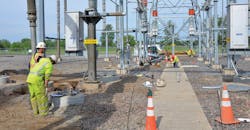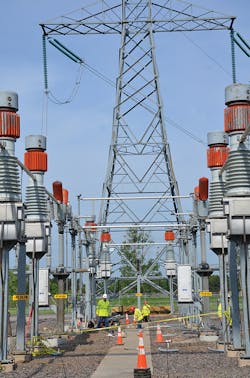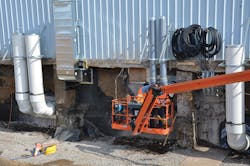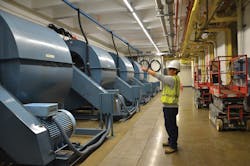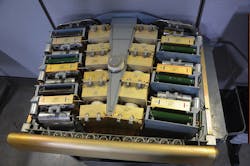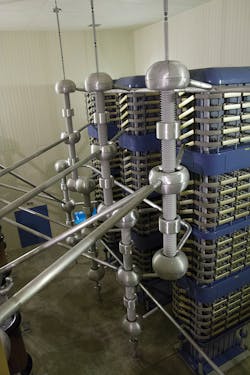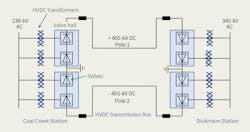Since 2011, electric generation and transmission cooperative Great River Energy has been preparing for a major upgrade to its high-voltage direct-current transmission system. Such systems are unique, and Great River Energy’s is one of a few of its kind in the world. It is also one of the utility’s most valuable assets because it delivers nearly all the power from Coal Creek Station, the co-op’s largest power plant, in Underwood, North Dakota, U.S., to Minnesota, U.S., where its 28 member-owner co-ops are located.
Great River Energy and ABB, the manufacturer of the utility’s high-voltage direct-current (HVDC) system, will complete the upgrade in spring 2019 during a planned 74-day HVDC system outage. The project will merge today’s HVDC technology with the existing system, helping to ensure Great River Energy and its member co-ops can count on continued reliability for the next 30 years.
The System
Great River Energy’s HVDC system is made up of a 436-mile (702-km), 400-kV transmission line and two converter stations, one at Coal Creek Station and one at Dickinson Station near Buffalo, Minnesota. The converter stations are where power is converted from alternating-current (AC) power to direct-current (DC) power and vice versa. They are composed of two mirrored and separated sections called poles. Each pole can deliver one-half the total capacity, or 550 MW, and uses one of the two transmission line conductors. The overall system has a total design capability of 1100 MW. The two-pole converter configuration provides system operational flexibility and reliability during fault conditions.
The Great River Energy HVDC system is also one of the last in the world to use complex air-cooled valves, whereby a glycol-based system with cooling towers, water treatment and heat exchangers are employed to provide a steady stream of cool air across the power electronics.
Great River Energy’s HVDC system has been one of the most reliable HVDC systems in the world since it was constructed in 1978, supplying nearly 70% of the co-op’s total generation capacity at nearly 100% availability. While its performance has been exceptional, the system is now 40 years old. It has long been expected, without a major investment, reliability would likely drop below Great River Energy’s high standards beyond the 2020 time frame.
Trigger and Response
In April 2008, an HVDC transformer failed, taking out one pole, or half the capacity, of the HVDC system for the week or more it took to put a spare in place. Because HVDC equipment is specialized, the transformer that failed took 24 months to rebuild. During that time, Great River Energy’s senior management, along with engineering and maintenance staff, started asking questions about the life span of the HVDC equipment, risks and likelihood of a long-term equipment-based outage.
In 2011, a comprehensive HVDC system assessment was initiated with the objective of reviewing every critical trip-worthy component on the system for condition, life span, obsolescence and criticality of operation. Great River Energy employees expected the HVDC transformers to be at the top of the risk list. However, it was the power conversion electronics, complex air-cooling system and control system that surfaced as the top three risks.
Worse, some power conversion electronics were identified as having oil-filled components, which presented a catastrophic fire risk because of the possibility they could leak oil, dry out and overheat. The lead time to replace the power electronics was estimated at 36 months. The system assessment clearly indicated Great River Energy needed to address the aging conversion electronics within the next nine years.
Due Diligence Begins
A team of Great River Energy leaders, engineers, field technicians, finance and risk personnel explored viable options and the associated business cases. Three main options were analyzed:
- Do nothing
- Build brand-new converter stations
- Refurbish the critical components of the HVDC system, replacing all major components in the converter stations on either end of the transmission line. This was considered the upgrade option.
The do-nothing option was the first option dismissed because of the reliability ramifications. Ironically, the team felt that death by 10,000 cuts, or continuous component-based system failures, was the worst-case scenario given that fault analysis with power electronics and aging control systems is not an exact science; there is a phenomenon known as the bathtub curve of failure whereby components work until they fail unexpectedly, having shown no precondition symptoms.
At first, the option of building brand new converters was a favorite of the majority of the team because of an early ballpark vendor estimate that was competitive with refurbishment. However, after due diligence was complete and specifications for brand-new converter stations were issued to potential HVDC manufacturers in 2013, the bids came in significantly higher than expected. As a result, the project team could not justify the excessive cost vs. the little additional benefit to the third option.
Ultimately, the upgrade option was agreed to, as it would provide the best value in terms of long-term reliability for the expenditure. The team then moved on to the next phase of the project, which was developing the scope of work, timing, outage requirements and budget.
Planning Forward
Because the HVDC system is required for operating Coal Creek Station at full load and is, for all intents and purposes, the only outlet for bringing the plant’s generation into the Minnesota power grid, the next phase was to review the planned HVDC system outage schedules to coordinate the upgrade with generation outage sequences. The years with the longest consecutive outages were 2019 and 2020, which provided a potential opportunity to replace one pole, or half of the capability, in 2019 and the second pole in 2020, which would complete the project.
A hybrid option emerged, whereby the 2019 outage would be extended to complete work on both poles and the 2020 outage would be used as a contingency outage in the event the utility encountered insurmountable problems. As this approach provided efficiency, project continuity and overall cost advantages, the decision was made to extend the 2019 outage to complete the work, leveraging 2020 as a contingency.
The team worked backward from the 2019 HVDC system outage time frame and duration, putting together a timeline for start-up, system testing, installation, equipment delivery, material lead times, design engineering and system planning.
To take advantage of the 2019 outage schedule, the team needed approval by Great River Energy’s board of directors in 2015. To obtain approval, the team worked for two years to develop a detailed and comprehensive scope of work, put together system specifications, bid the project and negotiate terms for the final contract.
In December 2015, Great River Energy awarded the project to ABB. The project included replacing the conversion equipment, cooling system, controls, DC yard equipment and smoothing reactors. The award was based on a 74-day HVDC system outage in 2019 with all major equipment to be delivered to the sites by the end of 2018.
All the analysis the team had done since the 2008 transformer failure indicated there was still life left in the units, so the HVDC transformers were not included in the project. In addition, Great River Energy had spare transformers on hand should the need arise.
Executing the Plan
Great River Energy and ABB formulated their project teams and began work in 2016, starting with planning studies and design engineering. Great River Energy was heavily involved in design engineering, working closely with ABB to ensure project specifications were met.
Design engineering continued into 2017 with the final design being issued at the end of the year. Great River Energy and ABB leveraged short, planned HVDC system outages in 2016 and 2017 to help further refine the overall design.
In early 2018, Great River Energy and ABB began the factory testing phase, which included thyristor modules, dry core smoothing reactors, arresters, cooling towers, cooling skids and treatment skids. In spring 2018, ABB began civil engineering work to help ensure successful construction the following year.
During an HVDC system outage in late spring 2018, underground work at both converter stations was completed. This was challenging as it was a relatively short time period—only nine days. However, it was critical the underground work be completed in 2018 because early spring frost presents conditions that are not conducive to foundation construction. There would be no time in 2019 for the foundation construction to be completed between the end of winter and the outage.
This short outage was busy with more than 100 workers from different contractors at each site for the nine-day period. The underground work included saw cutting more than 45 large holes in the basements of the converter stations and pouring more than 60 pier foundations. ABB also conducted the final valve system tests to prepare for the shipment of equipment in late 2018. The outage was successful. There were no safety incidents, the assigned work was completed and valuable lessons were learned.
Other activities continued as well. Work that could be performed with the system in operation continued throughout 2018 at both converter stations. This work included installing cable and new cooling towers as well as building assembly facilities. Detailed planning also continued throughout 2018 with Great River Energy, ABB and its subcontractors thinking ahead to help ensure a safe, quality 2019 upgrade.
The Results
Working with ABB, Great River Energy will complete an upgrade of its unique 436-mile HVDC system in spring 2019, when it replaces all the major components in its converter stations with current technology. Because of advancements in technology, the number of power conversion electronic components will be reduced by approximately 70%, bringing the number of thyristors down from approximately 8600 to only 2600.
Overall, the project will bring Great River Energy and its member-owner co-ops a number of significant benefits. It will extend the life of this vital system and help to maintain long-term system reliability for 30 years or more. Fire hazards will be reduced when air-cooled valves are replaced with water-cooled valves, removing oil-based capacitors and reducing the risk of a catastrophic fire. There will be efficiency gains of at least 7 MW as well as an increase in transfer capability as a result of an increase in operating voltage. The overall goal is fewer line and plant trips aimed at reducing wear and maintenance needs at Coal Creek Station, the co-op’s largest power plant.
Tony Ramunno ([email protected]) has been with Great River Energy for 18 years. As the director of power delivery, Ramunno has direct overall responsibility for transmission capital projects, design, construction and maintenance. He holds a BS degree in engineering from Youngstown State University and an MS degree in engineering from the University of St. Thomas. Ramunno has 30 years of experience in the electric utility industry.
For more information:
ABB | www.abb.com
Great River Energy | www.greatriverenergy.com
About the Author
Tony Ramunno
Tony Ramunno ([email protected]) has been with Great River Energy for 18 years. As the director of power delivery, Ramunno has direct overall responsibility for transmission capital projects, design, construction and maintenance. He holds a BS degree in engineering from Youngstown State University and an MS degree in engineering from the University of St. Thomas. Ramunno has 30 years of experience in the electric utility industry.
